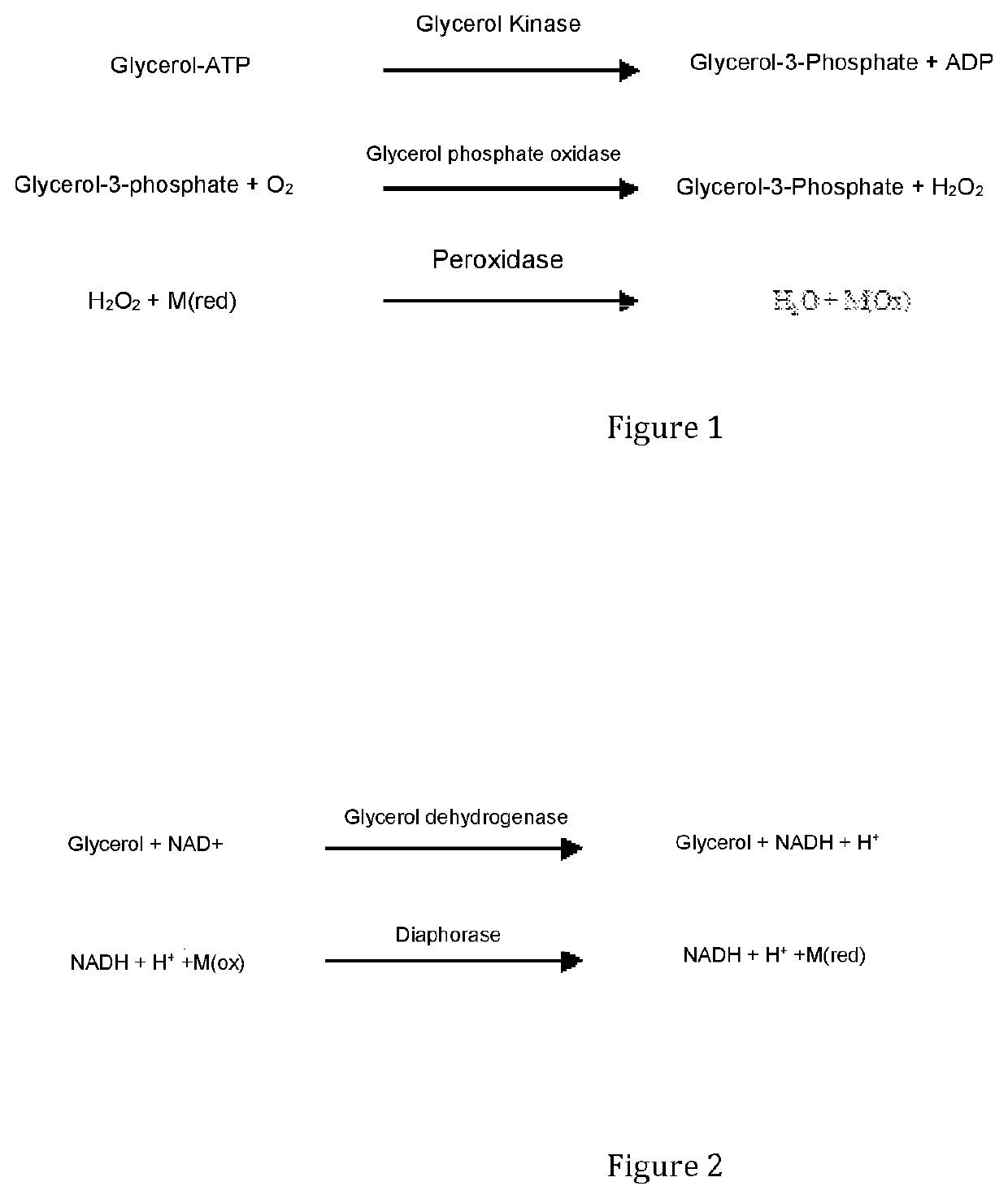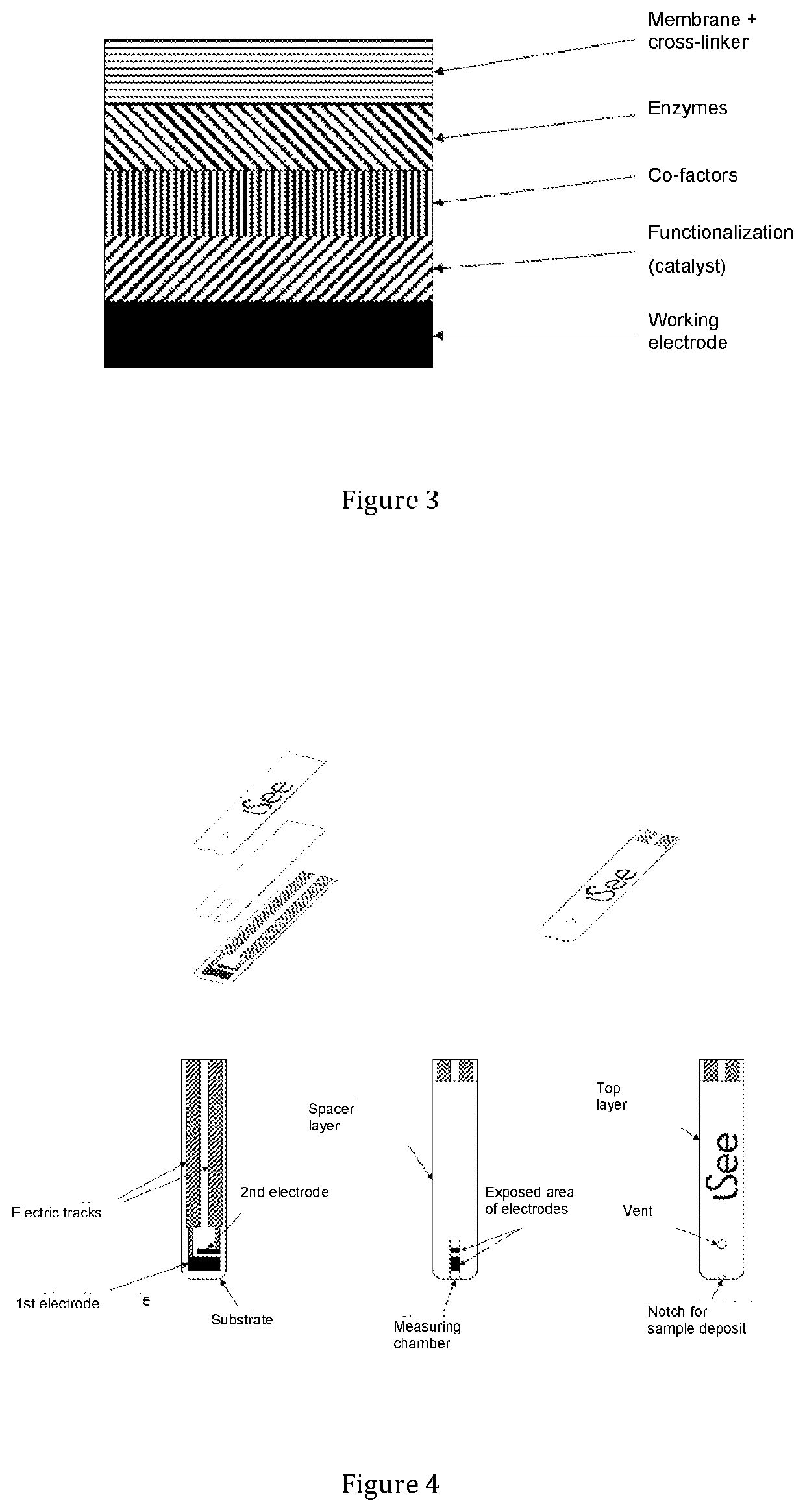Electrochemical strips for monitoring the degradation of body fat and method for preparing same
a technology of electrochemical strips and body fat, which is applied in the field of personalized monitoring of changes in metabolism, can solve the problems of unreliable markers and unsuitable systems for whole blood testing, and achieve the effect of facilitating data recording, analysis and monitoring over tim
- Summary
- Abstract
- Description
- Claims
- Application Information
AI Technical Summary
Benefits of technology
Problems solved by technology
Method used
Image
Examples
example 1
on of an Electrochemical Test Strip for the Detection of Glycerol
[0115]a. Strip produced by successive deposition of the different layers of components of the sensitive layer
[0116]On a polyimide substrate layer pretreated for 15 minutes with UV light in the presence of ozone, a first layer is screen printed with carbon ink to deposit the working electrode and 2 electrical tracks, the working electrode being contiguous to one of the electrical tracks. The strip is then dried in the oven at 120° C. for 10 minutes.
[0117]A second layer is then screen-printed with silver ink to deposit the reference electrode (also acting as a counter electrode), which is contiguous to the second electrical track. The strip is then dried in the oven at 120° C. for 10 minutes.
[0118]A third layer is then screen-printed with an insulating ink to partially cover the electrical tracks and the electrodes, leaving a part of the electrical tracks free so that the strip can be connected to the reader and a part o...
example 2
nt of the Quantity of Glycerol by Amperometry
[0137]A drop of blood of approximately 3 μL is applied to the strip at the notch in the top layer.[0138]a. Protocol for detecting the amount of glycerol present in the blood sample[0139]This protocol is suitable for the use if a strip as described in Example 1a[0140]The sample is incubated in the measuring chamber for 3 seconds.[0141]Then an electrical potential difference of −0.2V is applied between the working electrode and the reference electrode.[0142]The current value is measured 30 seconds after the start of the potential difference application.[0143]b. Use of data to quantify lipolysis[0144]i. Construction of a calibration line using measurements at several concentrations
[0145]As shown in FIG. 5, glycerol of known concentration was added to venous blood samples taken from a volunteer in order to obtain blood samples with different concentrations of added glycerol. These samples are analyzed using the technique described above and t...
example 3
ta by a User
[0148]The user turns on the meter and inserts a test strip. It then generates a drop of capillary blood at the tip of a finger using a lancet device and deposits it in the notch of the test strip provided for this purpose.
[0149]The meter performs the amperometric measurement as described above and transmits the result to a second connected device, which may be the user's smartphone. The instrument uses the preset calibration data and translates the current value into the amount of degraded fat mass. This quantity is then displayed to the user via a screen on the second device. This quantity can also be analyzed by the device, such as a comparison with the user's previous measurements or an interpretation of the measurement in relation to external factors that the user has entered into the application, i.e., the type of physical exercise or the nutrients ingested.
PUM
 Login to View More
Login to View More Abstract
Description
Claims
Application Information
 Login to View More
Login to View More - R&D
- Intellectual Property
- Life Sciences
- Materials
- Tech Scout
- Unparalleled Data Quality
- Higher Quality Content
- 60% Fewer Hallucinations
Browse by: Latest US Patents, China's latest patents, Technical Efficacy Thesaurus, Application Domain, Technology Topic, Popular Technical Reports.
© 2025 PatSnap. All rights reserved.Legal|Privacy policy|Modern Slavery Act Transparency Statement|Sitemap|About US| Contact US: help@patsnap.com



